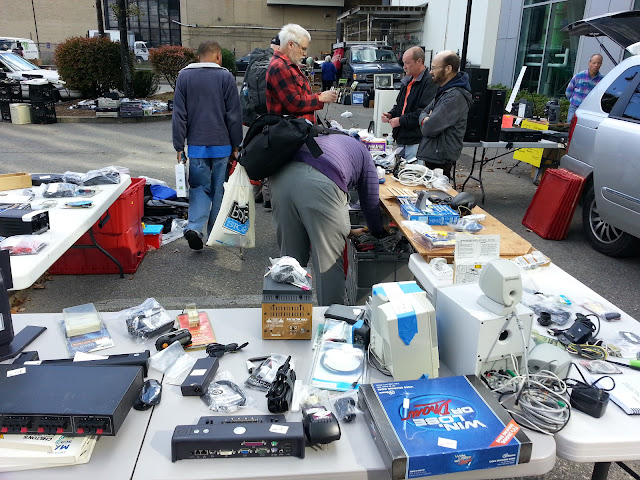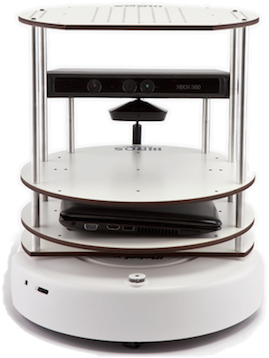(Sounds like a book title, or something.)
MOTORS!
 |
| ALL THE MOTORS! |
I found these gems from a couple of vendors at Swapfest. THREE MAXON MOTORS! THE BIG PITTMAN ONES HAVE 100 CPR QUADRATURE ENCODERS IN THEM!! I HAVE SEVEN OF THEM!!! *NERDGASMMMMMM!!!!!!*
SWAPFEST!
Swapfest is a monthly flea market hosted at MIT, where ass-tons of electronics and other hardware is sold from sketchy surplus purchasers.
 |
| Look at all them electronics. |
Back to why I am so excited:
Pittman/AMETEK... This is the same company that makes the two $200.00 gearmotors that I used in 6.141 last Spring. The same motor whose amazing quadrature encoders gave us insanely precise odometry. I basically own seven of the 6.141 motors, minus the heavy gearing (which I can easily do myself).
 |
| Here you can see the Quadrature Encoder connector, with the dark green shield cable |
Some of you may be asking, what the is a quadrature encoder, anyway? Well a regular encoder is a system you attach to a shaft to measure rotation. Inside there's a small disk with holes cut out of it that looks like this:
A light source and sensor pair are placed at the same radius away from the center shaft as the track, on opposite sides of this disk. As the beam is broken by the wheel, an interrupt is sent to whatever microcontroller is processing the encoder data and a counts value is iterated.
But Dan, how do I know if it's spinning one way or the other? If I move the shaft back and forth, the micro will just keep adding values!
That's why the word Quadrature is so special. Quadrature encoder wheels look like this:
They have two tracks on the disk, and have two light sensors instead of one.
First of all, this quadruples your resolution (hence the name "quadrature"). The tracks are 90-degrees out of phase, so every four ticks the pattern of Channel A to Channel B repeats: Black Black, Black White, White White, White Black. If you parse this correctly, you can determine which direction you're spinning. YAY!
With a strong build and an insanely high quadrature encoder resolution of 1000 counts per revolution The possibility of these motors are endless. I can put two of these on a mobile robot more powerful than TurtleBot's iCreate (In fact, I should start working on an Open-Hardware iRobot Create replacement Turtlebot-Compatible mobile platform!). I can use a few of these to make a low-DOF high-power manipulator. I can use all seven of them to make a high-quality 7-DOF manipulator comparable to the Barrett WAM arm.
Woah...
So what exactly can these motors do?
Here's a laser Tachometer that measures how often a reflective tape passes its lens in RPM. I placed some aluminum tape over one side of a motor's output shaft.
I hooked up a motor to a variable power supply and pointed the Tachometer to it, and did some Science.
I took down my measured RPM at a range of voltages for the motor. The slope of the best fit line created by plotting these points will be the motor constant in RPM/Volt, seen here in cell A12.
 |
| The data also makes for a pretty graph. Look at how linear DC motors are! |
By taking the inverse of Kv, you can find Kt. This led me to the following empirically-tested parameters:
Kv = 340.327 RPM/Volt = 35.639 radians per second per volt
Kt = 0.1763 newton meters per ampere
In order to get a VERY rough estimate of the max torque output of this thing, I held onto the motor shaft and applied some voltage until I couldn't hold it by hand anymore without hurting myself. I applied around 12V (which is good, I would probably use this off of an ATX power supply in the future) and read the current output as I stalled the shaft. The current went up to approximately 3 Amps.
Kt * maxCurrent = .1763 Nm/A * 3 A = 0.5289 Nm at 12V
For teh lulz, I wanted to see if it could pick up a soda can.
Soda can mass: .390kg =~ 1lb
Soda can gravitational force: .390kg*9.8m/s^2
.5289Nm/(.390kg*9.8m/s^2) = 5.45 Inches
This thing can cantilever a 1-lb load at almost 6 inches by my sketchy calculations. NICE!
Still curious to see what these motors could REALLY do, I decided to call up Pittman/Ametek to see if the datasheet was available on their end. Joe from their engineering tech support dept. was able to pull it up in seconds and email me the file, which contained a scan of an old-looking printout with some handwriting on it. The sheet is dated 1992, way back before human beings were civilized and purchased things on the internet.
Turns out their motor constant was ~ 332RPM/volt, so I'm pretty damn close. Their rated stall current is 10 Amps, so my 3-Amp estimate is way underrating the kind of power this thing could put out at 19.1 Volts! These are some kick-ass motors!
AND I HAVE SEVEN OF THEM!
What's better than Pittman motors? Maxon Motors. Maxon is a Swiss company that makes beautiful motors for precision control, usually with planetary gearing and encoders built in. I first ran into them my first summer at MIT, working the for Media Lab Personal Robotics Group as a solder/code monkey on the team that made this adorable and cuddly robot.
They're also hella expensive. A brushed Maxon gearmotor on their catalog today of this size (16mm diameter) will run you like $70.00. I got these for $5.00 each!
I'm too lazy to do the Tachometer thing with these motors, so I'll probably call up Maxon and try to get the datasheet somehow, because Maxon is notorious for taking their older model motors' datasheets offline.































